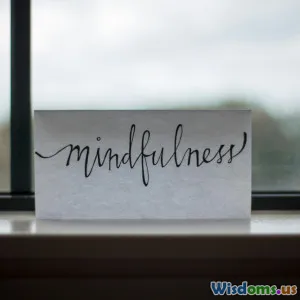
Modern Meditation Apps Are They Diluting Ancient Self Realization Practices
9 min read Exploring if meditation apps simplify or distort ancient self-realization traditions in a digital age of mindfulness. (0 Reviews)
Modern Meditation Apps: Are They Diluting Ancient Self-Realization Practices?
Introduction
In recent years, meditation has undergone a revolutionary transformation. What was once an esoteric, often secluded practice tied to ancient philosophies and spiritual traditions has become a mainstream wellness trend accessed by millions through sleek, user-friendly mobile apps. Popular platforms like Headspace, Calm, and Insight Timer advocate mindfulness and self-awareness with guided sessions seamlessly integrated into daily life. Yet this raises a critical question: do these modern meditation apps dilute the profound and multifaceted journey of ancient self-realization?
This inquiry delves into the heart of what meditation originally set out to achieve—a deep awakening of consciousness, liberation from suffering, and a fundamental understanding of the self rooted in centuries of wisdom traditions. Balancing convenience with depth, these apps democratize meditation but may also risk oversimplifying or commercializing sacred experiences. Is this evolution beneficial, problematic, or a bit of both?
The Origins and Depth of Ancient Self-Realization Practices
Historical and Cultural Foundations
Meditation and self-realization trace back thousands of years, found in Hinduism, Buddhism, Taoism, Jainism, Stoicism, and various indigenous traditions. In these contexts, meditation was rarely just relaxation—it was a disciplined, transformative journey toward "moksha," "nirvana," or profound interconnectedness. The ancient yogis and sages viewed it as a holistic process involving ethical conduct, deep philosophical inquiry, breath control, posture, and mind training.
Principles That Defined Ancient Meditation
- Ethical groundwork: Yamas and niyamas in yoga established a moral foundation.
- Long-term commitment: Meditation was a lifelong, rigorous practice requiring silence, solitude, and often guidance by a teacher (guru).
- Transcendence focus: The goal was liberation from the ego and illusion, not just stress relief.
For example, Patanjali's Yoga Sutras emphasize the eight limbs of yoga, where meditation (dhyana) is preceded by moral discipline (yama), observances (niyama), breath control (pranayama), and concentration (dharana). This comprehensive approach suggests that meditation was not standalone but embedded in a broader path.
Modern Meditation Apps: Accessibility and Appeal
Breaking Down Barriers
Modern meditation apps provide unprecedented access, offering diverse guided sessions suited to different needs—stress, sleep, focus, anxiety, and more. Data shows mindfulness app usage grew 30% globally from 2019 to 2023, signaling a demand for mental wellness tools in fast-paced societies.
Features and Innovations
- Structured programs: Variety of courses ranging from beginner levels to advanced themes.
- Biofeedback integration: Some apps sync with wearables to tailor practices.
- Community components: Forums, challenges, and social sharing to keep motivation high.
The Democratization Effect
By bringing meditation to smartphones, apps dismantle geographic and socioeconomic barriers, making practices once offered only by specialized teachers more accessible. Experts like meditation teacher Sharon Salzberg acknowledge that such tools can spark initial engagement, especially in Western populations unfamiliar with deeper traditions.
Do Apps Simplify or Dilute? An Analytical Perspective
Streamlining vs. Oversimplification
While apps distill complex techniques into bite-sized sessions (5–10 minutes), this brevity serves attention spans and busy lifestyles. Yet it also risks transforming meditation into a quick stress fix, losing its contemplative and existential depth. For example, many users pursue apps predominantly to reduce anxiety or improve sleep—not to embark on a spiritual quest.
Commercialization Concerns
Meditation apps operate as businesses with subscription models and market-driven incentives. Critics argue this commodifies a sacred practice, possibly leading to "mindfulness lite" experiences devoid of traditional context or ethical education. Meditation scholar Ronald Purser warns of "McMindfulness," where spirituality is repackaged for consumerism.
Positive Reframing: Accessibility as Empowerment
On the other hand, many voices emphasize that replication and adaptation are natural for spiritual practices to survive across ages. Even Buddhist and yogic traditions evolved with changing social realities. Apps can be gateways, making ancient teachings approachable and inviting newcomers to deeper explorations later.
Impact on Teachers and Traditional Lineages
A challenge lies in preserving teacher-student relationships fundamental to authentic transmission. Apps may crowd out personalized guidance, risking misunderstanding or shallow application. However, hybrid models appear, where app users participate in retreats or live sessions enhancing digital learning.
Case Studies and Real-World Insights
Headspace: From Stress Relief to Mindful Living
Founded by Andy Puddicombe, a former Buddhist monk, Headspace balances ancient mindfulness with modern psychology. The app's popularity with over 70 million users worldwide showcases effective translation of traditional meditation techniques. However, Puddicombe himself acknowledges that the app is "not a spiritual crusade" but a mental health tool.
Insight Timer and Depth through Diversity
Offering 100,000+ free guided meditations, Insight Timer hosts teachers ranging from Matangi to Tara Brach presenting context-rich, traditional and contemporary methods. Its open platform supports immersion beyond simplified sessions, fostering discovery.
User Experiences
A recent survey by the American Mindfulness Research Association indicated 62% of app users report stress and anxiety relief, but only 20% engage with apps seeking transformational spiritual insights. This gap highlights different motivations and levels of practice.
Recommendations for Mindful Engagement with Meditation Apps
- Approach apps as entry points, not final destinations: Use them to cultivate consistency and curiosity.
- Seek contextual learning: Complement apps with reading authentic texts and following qualified teachers.
- Remain critical of commercialized narratives: Avoid the trap of quick fixes; understand meditation’s depth.
- Balance tech use with silent, contemplative practice: Allocate time offline for personal work.
- Explore community and retreat opportunities: Engage in immersive experiences for embodied understanding.
Conclusion
The rise of modern meditation apps undeniably democratizes access to practices once confined within closed traditions, offering relief and mindfulness to millions. However, this convenience may simultaneously simplify, segment, or commercialize ancient self-realization paths that demand ethical discipline, patience, and profound inquiry.
Meditation’s ancient roots embody a holistic lifestyle and transformative journey, not a mere product for instant stress reduction. The key for contemporary practitioners is to harness app technology wisely—as a supportive tool intertwined with study, guidance, and introspection rather than a standalone panacea. Through conscious engagement, meditation apps can serve as doorways rather than diluters, inviting new generations to the timeless quest of awakening.
As the digital and spiritual realms integrate, the challenges and opportunities are equally profound. Reflecting on this evolving landscape encourages us to maintain respect for tradition while embracing accessibility—paving a balanced path toward genuine self-realization in modern life.
References and Further Reading:
- Salzberg, Sharon. Real Happiness: The Power of Meditation (Workman Publishing, 2010)
- Purser, Ronald & Loy, David. Beyond McMindfulness (2013)
- Headspace Inc. User demographics and platform data, 2023
- AMRA Survey on meditation app use, 2022
- Patanjali’s Yoga Sutras (translation and commentary by Edwin Bryant)
Rate the Post
User Reviews
Popular Posts
















